The 25th Anniversary of the Large Blue reintroduction was celebrated on 16th June 2009 at Montacute House in Somerset. Following a welcome reception, we were treated to presentations from Sir David Attenborough, Professor Jeremy Thomas (Professor of Ecology at the University at Oxford and Fellow, Centre for Ecology and Hydrology), Professor Lord May of Oxford (Past President of the Royal Society) and Dr. Helen Phillips (Chief Executive of Natural England). The event was ably chaired by Professor Debby Reynolds (Chair of the National Trust Nature Conservation Panel). The presentations were followed by a trip to a Somerset site to see the largest Large Blue colony on the planet. This report is my record of this wonderful day.
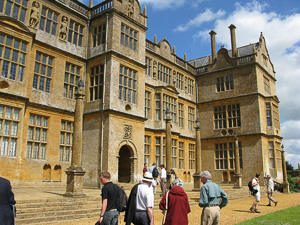 |
| Montacute House Image © Peter Eeles |
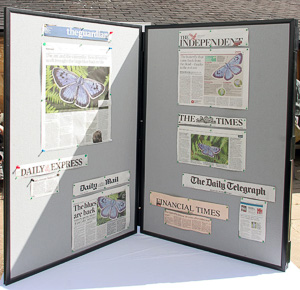 |
| Barnaby Smith and his CEH Press Team had done an outstanding job - even getting recognition in the Financial Times! Image © Heather Lowther / Centre for Ecology & Hydrology |
Sir David started by saying it's now 11 years since the first reintroduction at "Site X" in Devon, and that the number of people to thank for that is huge; he suspected that 50% of the attendees deserved thanks for the direct work that they've done. Although Sir David's introduction was relatively-short, his handover expressed the admiration shared by everyone in the room - "I won't stand between you and the greatest of the experts - Professor Thomas".
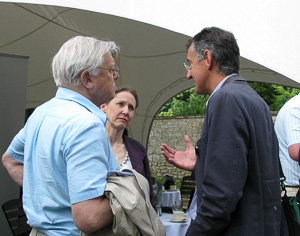 |
| Sir David Attenborough and Dr. Martin Warren Image © Peter Eeles |
Jeremy started by highlighting the contribution of David Simcox to the reintroduction project. He also pointed out that the success of the project was made possible through the harmonious collaboration of many different conservation and commercial organisations.
He went on to say that the Large Blue is one of the few globally threatened species that we have in Britain and that it was the combination of its beauty, the global threat to its existence, and its extraordinary lifecycle, that made the IUCN (the International Union for Conservation of Nature and Natural Resources) choose it as one of the three priority insect species for conservation some thirty years ago. Two other butterflies were also identified as being globally threatened at that time; the Monarch and Queen Alexandra's Birdwing (the largest butterfly in the world). "The Large Blue has been a special butterfly not only to me - but also internationally."
Jeremy then went on to discuss the reintroduction process as having gone through four phases: 1) steady decline (based on educated guesses), 2) enlightenment (based on intensive research that led to a much better understanding of the ecology of the Large Blue), 3) testing (to see if the Large Blue could be reintroduced in the UK to determine if the theories were correct) and 4) the restoration of sites. Jeremy took pride (quite rightly!) in telling us that there are now 33 colonies in the UK, which is a number not seen since the 1930s.
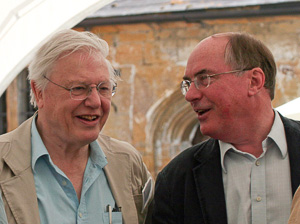 |
| Sir David Attenborough and Professor Jeremy Thomas Image © Heather Lowther / Centre for Ecology & Hydrology |
Jeremy outlined his initial involvement in the project. He told us that he was very lucky; when the species was down to its last few colonies he was asked to spend a significant amount of time (ultimately, 6 years!) in the West Country to determine if there was a key factor that was driving this species to extinction. This resulted in Jeremy identifying 28 different factors that, for example, caused the female to lay more or fewer eggs, the adults to emigrate or immigrate, the immature stages to perish, and so on. Jeremy condensed these factors into a mathematical model containing eight significant factors (the formula for which was shown!). However, one factor was extremely significant; the presence of a single species of red ant - Myrmica sabuleti. Jeremy also explained that earlier ecologists may have missed this significant factor because there is a very similar red ant (Myrmica scabrinodis) that can easily be confused with Myrmica sabuleti. Jeremy concluded this discussion by showing a remarkable correlation between his mathematical model (the theory) and the actual results (the practice).
Jeremy went on to explain that focusing on habitat management for Myrmica sabuleti was critical in ensuring the success of the Large Blue. For example, this ant needs a sward between 1cm and 3cm in height (that provides sufficient warmth) that allows the ant colony to flourish. Jeremy then provided several examples of sites where the habitat had been managed specifically for Large Blue - including a former conifer plantation. He also gave another example where the express line from Paddington, running through the Polden Hills, provided an opportunity to rebuild an embankment that not only met the mechanical needs of the line, but also the ecological requirements of the ant (and therefore the Large Blue) - such as the chemistry of the soil, the depth of the soil and so on.
Jeremy's presentation then looked further afield. He said that the National Trust has done a wonderful job at Collard Hill that provides an open access site for those wanting to see the Large Blue. However, other species of animals and plants have benefited too (such as the Pearl-bordered Fritillary) and that this should not come as a surprise since a habitat had been reintroduced that had disappeared and, once this habitat had been recreated, some species were able to recolonise.
Looking at the bigger picture, Jeremy acknowledged the concerns around a changing climate, and said that sites had been designed that provide a mix of areas that are either cool or warm, wet or dry - and this variety of habitat will cater for such changes in the climate. Jeremy concluded by looking at European initiatives. He explained that his work has been applied to four species of Maculinea through the support of an EU grant (the Macman project) and the efforts of over 100 conservationists and ecologists. Jeremy explained that some of these butterflies are even more specialized, and even have parasites that are more specialized; they their eggs in the Maculinea larvae - and are much rarer than the butterfly as a result.
I, for one, came away from Jeremy's session knowing that I'd listened to one of the leading scientists in the world explaining his life's work. It really was a privilege to be in the audience. I hope Jeremy's story (and work) not only encourages a focus on the conservation of other species, but also fosters an interest in the next generation of ecologists whose work is becoming increasingly-important in our ever-changing world.
Professor Debby Reynolds' introduction to Lord May made it clear that he is one of the foremost scientists of our time, who has won several distinguished prizes and awards - including one that is the equivalent of the "Nobel Prize" for Biology, as Debby put it. Lord May got straight to the point: "It's a real privilege and pleasure to be part of this celebration of what, I am sure, will be seen as one of the iconic stories of our time.".
Known for seeing "the big picture", Lord May started with a rather-profound statement: "It is the small things that run the world", before acknowledging that Jeremy's study is almost unique in that it focuses on an invertebrate. Such profound statements continued, with Lord May providing some statistical evidence to make the audience think: in the last 150 years, the human population has increased sevenfold. The average energy consumed by an individual has also increased sevenfold. So the footprint per individual has increased (approximately) 50 fold over the last 150 years. He went on to explain that, 20 years ago, we discussed population growth and that the current focus is on climate change. He predicts that in 10 to 15 years from now we'll be discussing how we feed the population and how we can provide sustainable water supplies to support the population. He observed that all of this focus is on the human race, rather than other species and that we forget that much of what we depend upon requires other species.
In keeping with his statement of "It is the small things that run the world", Lord May elaborated on his concern that we know so little about these "small things", that their rate of extinction is increasing, and yet we are dependent upon them.
Taking each of these points in turn, he provided an example of how little we know. He questioned somewhat-suspect predictions such as "27,000" species going extinct this year, before explaining that we really don't know how many species there are on our planet. He said that, while we have a good idea of the numbers for birds and mammals, theory tells us that there are between 3 and 10 million distinct species on earth, most of which are invertebrates. We therefore don't know how many will become extinct!
He then went on to discuss the rate of species extinction, which can be compared with the past in terms of the 1/2 billion year history in the fossil record. He said that, if we assume that the extinction rate of birds and mammals is typical of animals and plants in general, then what we are experiencing today is comparable with the 5 mass extinctions in the fossil record. We therefore stand on the tipping point of the 6th mass extinction - distinguished from the other mass extinctions by a single species - us - a species that is aware of what is happening.
Lord May then explained that the "services" provided by other species are significant to us. For example, they act as pollinators and provide clean water. He said that one estimate suggests that these services are roughly equal in value to the global GDP (gross domestic product)! He then summarised his thinking by saying that we therefore need to understand the details of declines - and that Jeremy's story with the Large Blue is one of the most elegant and most compelling in terms of what we can achieve and that, therefore, this story is of far greater importance than a particular species of a blue butterfly when one considers the bigger picture.
Lord May concluded with a very interesting view on what he called "the heart and the head". He gave the audience some basic statistics - if we divide the species on our planet into vertebrates, plants and invertebrates, then we have a fairly complete catalog of vertebrates that tells us there are around 40/50,000 species. He said that our understanding of plants is also very good - and that there are about 10 times as many species, giving us around 300,000 species in total. However, when it comes to invertebrates, we basically don't have a clue - but it's a very large number - in the order of several millions!
And yet, when we look at how we consider life on this planet, the emphasis we give to species in general is divided more-or-less equally into 1/3 vertebrates, 1/3 plants, 1/3 invertebrates. In other words, the emphasis is "out of whack" by a factor of 100 in terms of the emphasis placed on invertebrates versus vertebrates! Lord May then, based on an analysis of leading journals over the last 15 years, observed that the focus was even worse - the emphasis was 70% on vertebrates (birds and mammals), 20% plants, 10% invertebrates. He then commented that, although our emotions may relate more easily to the "furries and featheries" (mammals and birds!), it is largely invertebrates that run the world since they're fundamental to the functioning of most ecosystems and they also, as it happens, carry more of the genetic record of how life evolved on our planet. Our challenge, therefore, is to use the emotional resonance (the "heart") to determine which actions (the "head") will best-sustain the biological riches that we have inherited.
Lord May's conclusion was the perfect conclusion for the event: "This melding of "heart and head" doesn't come easy. The occasion this morning is an archetypal happy example of such a melding.".
Helen described the day as "the celebration of a conservation triumph". She explained that Natural England plays a key role in the partnership that supports the reintroduction of the Large Blue butterfly and that the story of the Large Blue exemplifies the very best and worst of our relationship with the natural world! I was intrigued! She explained the worst - the butterfly was driven to extinction by a failure to take into account the requirements of the natural world and what the Large Blue needed; it was increasingly squeezed in terms of habitat, it was hounded by collectors, and the bureaucracy of indecisive habitat management. As for the best, the Large Blue is now flourishing again thanks to the work of Jeremy and many others. This, she said, was a "staggering achievement" brought about by a "partnership brought to action", essentially bringing the Large Blue back from extinction.
Helen acknowledged the results that can be achieved when scientists, conservationists, government, business and local people work together to give nature a helping hand. She reserved a special word of thanks to the volunteers that make such an enormous difference. "Everyone who has been involved should be immensely proud of what's been achieved - this is one of the most successful conservation projects in the world".
Debby closed the event by introducing some remarkable video footage of the equally-remarkable lifecycles of the Mountain Alcon Blue (Maculinea rebeli) and Alcon Blue (Maculinea alcon), and their associated parasites, created by two Polish Lepidopterists. Jeremy admitted some trepidation in "doing an Attenborough" before providing a voiceover of the footage - in front of Sir David himself!
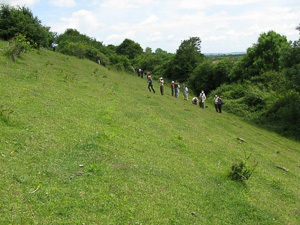 |
| The afternoon outing - watching Large Blues! Image © Peter Eeles |
From my personal perspective, today was an obvious highlight of my year. Not only was it a superb opportunity to put faces to names and meet some of the "legends" in the field of conservation - I also came away with a much better appreciation of what the many individuals and organisations do to make this planet a better and more-sustainable place. And they need all the support we can give.